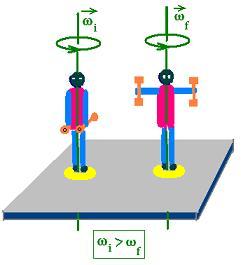Rotation
Contents
Applications
Worked examples
© The scientific sentence. 2010
Formulas
θ = (1/2) α t2 + ωot + θo
ω = α t + ωo
ω2 - ωo2 = 2 α (θ - θo)
ar = ω2(t) r
at = α r
Circ. Unif. motion:
1 rev = 2π rad
θ = ωt
v = ω r
T = 2π/ω = 1/ƒ
ar = ω2r = v2/r
at = 0
|
| Conservation of angular momentum
1. Conservation of angular momentum
Like conservation of linear momentum, the principle
of conservation angular momenum is a universal law, that
follows from the equation Σ τext = dL/dt;
where:
when Σ τext = 0 , L is constant
It means when a net external torque acting on a system is zero, the
total angular momentum of the system is constant (conserved).
Un ice skater pirouetting takes the advantage of this principle.
2. Example

Another example is a person standing at the center of a turntable
with two dumbbells of mass m each in each hand. The axial of the system
is vertical and passes in the middle of the person through her/his
center of mass. When the two hands
are extended horizontally, the moment of inertia of the system
is
Ii = Ipers_ext + Idumb_ext.
When the two arms are pulled, we have:
If = Ipers_pul + Idumb_pul.
Where:
Ii is the initial moment of inertia of the system,
Ipers_ext is the moment of inertia of the person alone
with arms extended,
Ipers_pul is the moment of inertia of the person alone
with arms pulled to in to stomach,
Idumb_ext is the moment of inertia of the two dumbells
with arms extended = 2 m dext2,
Idumb_pul is the moment of inertia of the two dumbells
with arms pulled to in to stomach= 2 m dpul2, and
If is the final moment of inertia of the system.
The only external force acting on the system
is the weight, which ha no torque with respect to the
choice of the axial. The total angular momentum L, at any
time, is constant. It is equal to Icmω,
where ω is angular velocity of the system about the axial.
The cnservation of angular momentum law is written as:
Constant = Icmω = Iiωi =
Ifωf
Iiωi =
Ifωf
Therefore:
ωf = Iiωi/If =
(Ipers_pul + dumb_pul)ωi/(Ipers_ext + Idumb_ext) =
(Ipers_pul + 2 m dpul2)ωi/(Ipers_ext + 2 m dext2)
m = 5 Kg, dpul = 0.2 m, dext = 1 m
Ipers_pul = 2.0 kg m2, Ipers_ext = 3.0 kg.m2
ωi = 1.3 revolutions per 1 second.
Ii = 2.0 + 2 x 5 x (0.2)2 = 2.4 kg.m2
If = 3.0 + 2 x 5 x (1.0)2 = 13.0 kg.m2
ωf = Iiωi/If =
2.4 x 1.3 /13.0 = 0.24 revolutions per second.
The angular speed decreases.
The corresponding kinetic energy is:
KEi = (1/2) Iiωi2
KEf = (1/2) Ifωf2
Therefore:
KEi/KEf = Iiωi2/Ifωf2 = ωi/ωf = 1.3 /0.24 = 5.42
or
KEf/KEi = 1/5.24 = 0.185 = 18.5%
When the two arms become extended the system losses speed,
then kinetic enery. When the arms are pulled, the system gain
kinetic enery. This exchange of kinetic energy is due to the
internal energy produced within the system. This internal
energy is negative by extanding the arms, and positive when
the arms are pulled.
Recall that the enery of a system is
the sum of the energy of its center of mass plus the
internal energy; which is the same measured in the reference
frame of the center of mass or in the refrence frame of lab
(at rest).
|
|